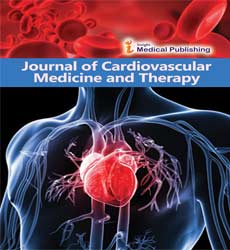Covid-19 Patients with Cardiac Arrhythmias
Department of Pediatric Cardiology, Zagazig University, Zagazig, Egypt
- Corresponding Author:
- Engy M
Department of Pediatric Cardiology, Zagazig University, Zagazig, Egypt
E-mail: mirsaeidien@gmail.com
Received date: February 01, 2021; Accepted date: February 15, 2021; Published date: February 22, 2021
Citation: Engy M (2021) Covid-19 Patients with Cardiac Arrhythmias. J Cardiovasc Med Ther Vol.4 No.1: 01
Abstract
Keywords
COVID-19; Arrhythmia; Heart failures
Description
Early studies recommend that coronavirus disease 2019 (COVID-19) is related with a high incidence of cardiac arrhythmias. Severe acute respiratory syndrome coronavirus 2 infections may cause injury to cardiac myocytes and increase arrhythmia risk. Coronavirus disease 2019 (COVID-19), caused by critical acute respiratory syndrome coronavirus 2 (SARS-CoV-2) [1], has emerged as a global pandemic, infecting more than 1 million patients in the United States as of early May 2020. Early reports from China recommended an overall cardiac arrhythmia incidence of 17% in patients hospitalized for COVID-19. A higher arrhythmia rate (44%) was noticed in patients with COVID-19 admitted to the Intensive Care Unit (ICU). However, details of the type and burden of arrhythmias in this population have not been clarified. Similarly, in another observational report from China that included 187 hospitalized patients. In addition, reports from Italy and New York City have reported a concomitant increase in out-of-hospital cardiac arrests [2] that are connected with the cumulative incidence of COVID-19. These findings scrutinize that SARS-CoV-2 infection and secondary cardiac injury may increase the arrhythmia risk. We sought to systematically assess the risk of cardiac arrest and arrhythmias including incident Atrial Fibrillation (AF), bradyarrhythmias, and Non-Sustained Ventricular Tachycardia (NSVT) in a large urban patient population hospitalized for COVID-19 [3].
Discussion
In our investigation of 700 patients with COVID-19 conceded over a 2.5-month time frame, 30 patients kicked the bucket in the medical clinic. We recognized 53 arrhythmia-related occasions including 9 heart failures, 25 occurrence AF cases, 9 clinically critical Brady arrhythmias, and 10 NSVTs. With the inconsistency of the heart failure cases, none of the 3 arrhythmia types were autonomously associated with intense mortality. Our discoveries suggest that the frequency of heart failures in patients with COVID-19 relates to the seriousness of sickness and isn't the sole result of the viral disease. The heart failure pace of 11% saw in our populace in the ICU approximates the 13% heart failure rate saw across New York. The somewhat higher rate in New York might be clarified by blend treatment with hydroxychloroquine and azithromycin-meds that bring about QT prolongation and freely increment the danger of heart failure. Patients with more serious foundational ailment as confirmed by ICU affirmation likewise had a higher probability of creating cardiovascular arrhythmias. The relationship with Brady arrhythmias could be clarified in the wake of representing segment and clinical contrasts, for example, fundamental cardiovascular danger components and infection between patients in the ICU and those admitted to a non-ICU setting. Ongoing discoveries from the University of Alabama at Birmingham likewise uphold the higher probability of noticing atrial arrhythmias in the populace in the ICU versus populace in a non-ICU setting. These predictable discoveries should feature contemplations for long haul anticoagulation treatment. Coronavirus can give thrombotic confusions including blood vessel and venous apoplexy. SARS-Cov-2 disease of endothelial cells is proposed to bring about a cytokine reaction with arrival of incendiary go between that lead to endothelial and hemostatic actuation. This fiery state may expand the danger of thromboembolic intricacies, particularly when AF is available. Future examinations should assess the best and most secure procedures for long haul anticoagulation and mood the board in this populace. Our examination has a few impediments. This examination was from a solitary community serving a huge metropolitan populace. In that capacity, our discoveries may not be generalizable to patients with COVID-19 from across the world. Moreover, a few patients in the non-ICU ward were taken off telemetry during their hospitalization [4,5].
Conclusion
Eleven percentage of patients were hospitalized for COVID-19 at our center and are admitted to the ICU. Heart failures and arrhythmias were bound to happen in the populace in the ICU than in the populace in the non-ICU ward even subsequent to controlling for hidden segment and clinical variables. Thusly, heart failures and arrhythmias are likely the outcome of fundamental disease and not exclusively the immediate impact of COVID-19 contamination. Episodes of COVID-19 subvert general prosperity anyway the related extra-pulmonary appearances and their drawn out outcomes are consistently ignored. Past reports uncover that cardiovascular arrhythmias are one of the normal inconveniences related with COVID-19, which may in some cases be life-threatening. We would propose that front-line clinicians screen heart cadence as business as usual consideration, and the information may reveal insight into whether COVID-19 related arrhythmic confusions is an autonomous indicator of antagonistic results. Early analysis and ideal treatment to lessen mortality is of urgent significance.
References
- Wang Y, Wang Z, Tse G, Zhang L, Wan EY, et al. (2020) Cardiac arrhythmias in patients with COVID-19. J Arrhythmia. 36: 827-836.
- Patil KD, Halperin HR, Becker LB Cardiac Arrest. Circ Res 116: 2041–2049.
- Hasty F, García G, Dávila H, Wittels SH, Hendricks S, et al. (2021) Heart rate variability as a possible predictive marker for acute inflammatory response in COVID-19 patients. Mil Med 186: e34–e38.
- Sisti N, Valente S, Mandoli G E, Santoro C, Sciaccaluga C, et al. (2020) COVID-19 in patients with heart failure: The new and the old epidemic. Postgrad Med J 97.
- Freaney PM, Shah SJ, Khan SS (2020) COVID-19 and heart failure with preserved ejection fraction. JAMA 324: 1499-1500.
Open Access Journals
- Aquaculture & Veterinary Science
- Chemistry & Chemical Sciences
- Clinical Sciences
- Engineering
- General Science
- Genetics & Molecular Biology
- Health Care & Nursing
- Immunology & Microbiology
- Materials Science
- Mathematics & Physics
- Medical Sciences
- Neurology & Psychiatry
- Oncology & Cancer Science
- Pharmaceutical Sciences
